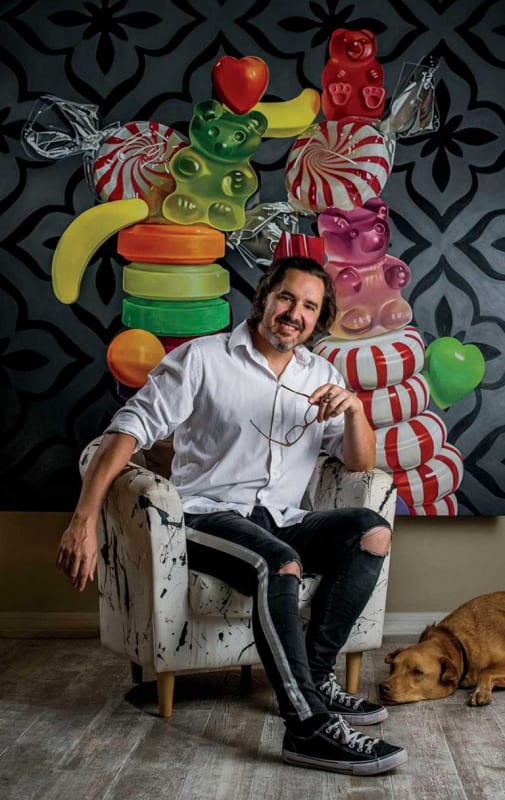John Schieffer depicts colorful everyday items in photorealistic paintings that pop.
By Rebecca L. Rhoades | Photography by Neal Mei
“Joy is one of the most important things that a person could strive to have in his or her life,” says artist John Schieffer. While many painters aspire to create works that make statements about society, politics or other controversial topics, Schieffer’s vivid, photorealistic still lifes are pure fun.
“I like to think of my work as joyful,” he says. “There’s a lot of art out there that’s taken very seriously, but I think it’s okay to create pieces that show beauty and evoke happy emotions.”
Focusing mainly on some of life’s small details, Schieffer explores texture, space and color by showcasing elements that often recall the pleasures of childhood. Clusters of glass marbles with brilliant rainbowlike ribbons of pigmentation that swirl through their translucent bodies shimmer against white and black backgrounds. Primary-hued plastic dice glisten as they burst through splashes of water. The metallic sheen of a single jack, rendered in an electric green or bright blue, radiates with mesmerizing intensity on an oversize canvas. Each piece is executed in a signature style that is bold yet elegant, playful yet refined.
A Connecticut native, Schieffer always knew he would be an artist. After graduating from Paier College of Art in Hamden, he began his career with a short stint as a children’s book illustrator, followed by years working as an art conservator.
Schieffer spent his days restoring 19th century works. His spare time was devoted to his own paintings, keeping the size and content to a minimum. “I would do a small painting of one or two marbles on a 2- or 3-inch-square board,” he recalls. “That’s how I got started working with marbles. I could finish a painting in a single evening.”
In February 2006, spurred on by rising home prices on the East Coast, Schieffer and his wife, Lorraine, relocated to Goodyear. With more time to devote to his craft, the size and complexity of his paintings grew. “In the last few years, I’ve added water and splashing objects. I call them moving still lifes.” And while he still does smaller works, his canvases can now be measured in feet, not inches. Typical sizes range from 4 feet square to diptychs that come in at a massive 8 feet square.
“John’s work definitely makes a visual statement,” says gallerist Christi Bonner Manuelito, who has represented Schieffer since he moved to Arizona. “His compositions are truly unique. They can be so very unexpected, which is especially important to art lovers and collectors. Plus, what he paints is very demanding, which makes each piece even more impressive.”
Many still-life painters traditionally use tabletop displays set up in their studios, but marbles roll around, candies melt, and a small bump can destroy a perfectly placed pile of miniature alphabet blocks. Because a single painting can take between one and three months to complete, Schieffer photographs his creations and works from the resulting image. “I need so much detail, so moving things even slightly or having a different light source can change the entire painting,” he explains. “Also, depth of field is nearly impossible to duplicate when you’re painting from life. It’s a trick of photography.”
Schieffer’s mastery of blending colors to capture luminosity, transparency and luster results in works that can fool even the most trained eye. “It’s all shades of gray,” he says, laughing at the suggestion of a glass-colored pigment. “If you paint an item exactly as you see it, then it will look transparent. Paint what you see, not what you think is there.
“Some people are amazed when they view the work in person,” he adds. “They think it’s a photograph, even when they’re standing right in front of it.”
Friend and fellow artist Dyana Hesson has known Schieffer for as long as he’s lived in the Valley and exhibited with him in group shows. “John remains very humble about his talent, but truthfully, he is a master of light, form and color. His rendering and careful attention to detail is evident in every painting,” says the Phoenix Home & Garden Masters of the Southwest award winner. “His works are bright spots of beauty and imagination in the homes of his collectors.”
Bonner Manuelito adds, “Many of our clients find his work awe-inspiring and reminiscent of their youth.” For some, it evokes nostalgic memories of playing jacks or marbles as a kid. One collector purchased a painting of candy hearts because it reminded her of her husband, who had just passed. “He had given her those sweets every year on Valentine’s Day, so she had a real emotional connection to the piece,” Schieffer recalls.
Although the artist dabbles in other genres, such as portraiture, and he even wrote and illustrated a children’s book, he continues to find pleasure in the tiny toys and colorful candies that inspire his imagination. “The unifying principle in my work is how I try to see the small details in life from a new perspective,” Schieffer says. “I want to shine a light on them and make them the biggest things in the room. Turning the mundane into something beautiful is important.”

